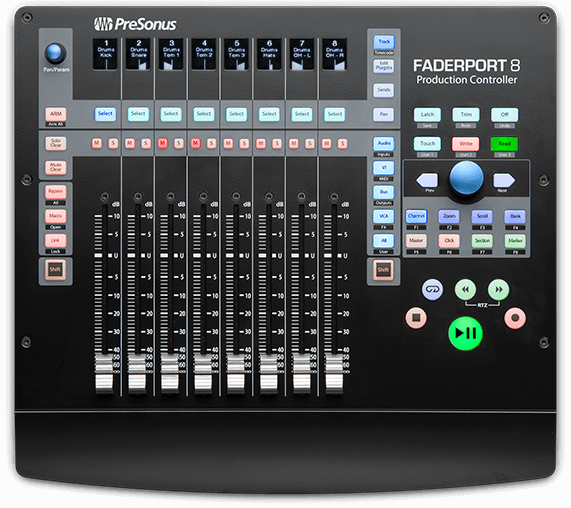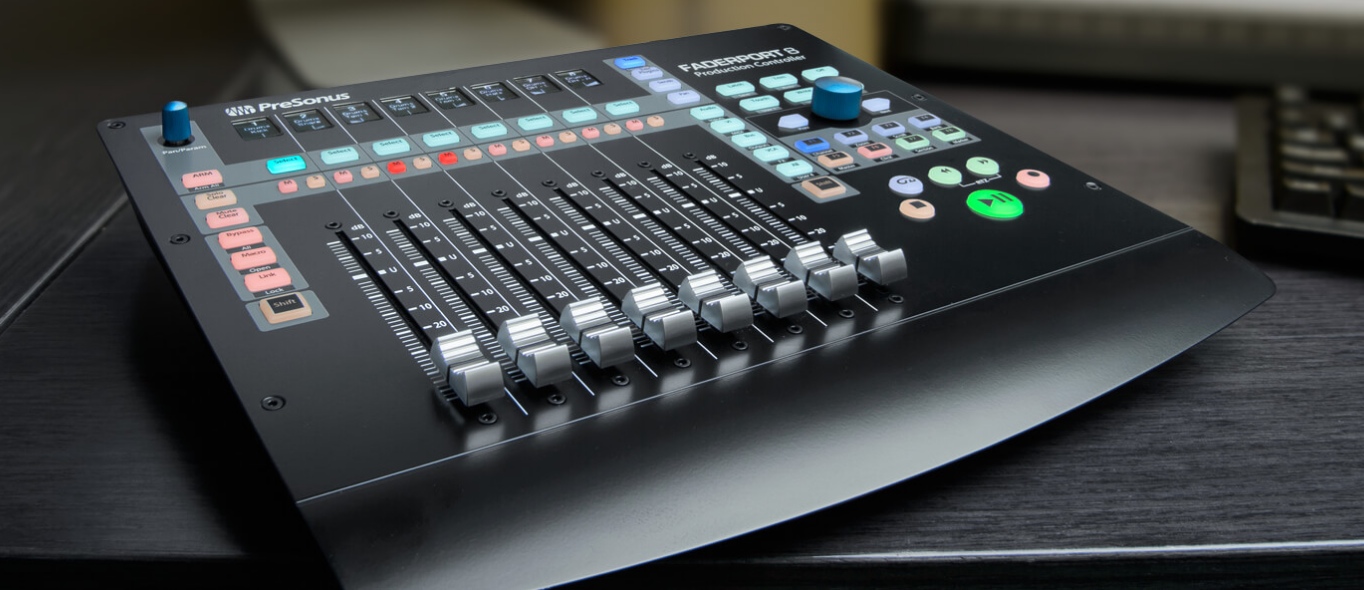New Gear Review: PreSonus FaderPort 8
Note: This review focuses on the FaderPort 8 in use with Pro Tools, which is the most popular DAW among SonicScoop readers, rather than with the native (and also capable) StudioOne software.

The FaderPort 8 streamlines the mix process by offering 8 touch-sensitive, motorized faders and 57 different buttons that preform a wide variety of tasks.
In today’s recording environment, a computer is the centerpiece of the studio. It is the focal point, the medium through which audio is captured, processed and manipulated.
As engineers, many of us long for more hands-on control of our DAW; sometimes, a keyboard and a mouse just don’t cut it. That is where the DAW controller comes in. Expanding your hands across a bank of motorized faders, you feel that sense of raw power once again. No longer are you a slave to the point-and-click method of mixing. Now, you can let the faders fly, writing automation and crafting mixes with ease.
The market is abundant with options for DAW controllers, but it is only very recently that motorized control surfaces have become remarkably cost effective. Priced at a shockingly low $499 street, the PreSonus FaderPort 8 is leading the charge of brands that seek to bring truly “flying” faders to the hands of the everyman audio engineer.
Features
With 8 motorized, touch-sensitive faders and an array of other controls, PreSonus offers a straightforward approach to digital control with the FaderPort 8.
Given the popularity of its predecessor, the 1-channel FaderPort, PreSonus seized the opportunity to provide a professional and affordable multi-channel control surface. Promising compatibility with several different DAWs, the latest FaderPort brings diversity and flexibility along with value.
Out of the box, the FaderPort 8 comes with everything you need to get started: The unit itself, a USB cable, a power cord, and a user manual. I set it up in the empty center space on our analog console to keep everything within arm’s reach.
This controller is compact enough to fit into many different applications, be it a home studio or a full-fledged control room. Setting it up to work with my DAW was a breeze: Create a PreSonus account, download and install the firmware update, open Pro Tools, and configure a few options in the Peripherals menu.
The FaderPort 8 operates in one of 3 modes: Native (StudioOne), HUI (Pro Tools), and MCU (Logic, Cubase, Ableton, Nuendo, Bitwig, Reaper, Reason, and more).
Holding the first two “Select” buttons during power-up allows you to choose the mode you’d like to work in. In this case, HUI was my mode of choice in operating with Pro Tools. After that, the unit was synced up and ready for mixing.
Along with the 8 motorized faders are 57 different buttons that perform a variety of functions. In Native mode, these buttons cover 78 different commands. (In HUI and MCU mode, a few of the native buttons serve no purpose, but the majority of buttons serve their desired function in all other modes.)
There are also 8 scribble strip displays, a complete and convenient transport section, individual channel controls (Mute, Solo, Level, and Pan), standard automation modes, and navigation controls for cycling through channels and navigating sessions.
The unit also has a plugin control button, which allows you to map the channel faders and buttons to your currently selected plugin. The faders can also map to bus sends and panning positions at the push of a button.
The big blue knob in the master section is another versatile control, allowing you to drop markers, navigate between markers, and zoom in and out. The FaderPort 8 also offers the ability to cycle through tracks channel-by-channel or in banks of 8, further streamlining the mix process.
In Use
Having used other controllers that implement the HUI control protocol, I was a bit apprehensive about how well the FaderPort 8 would work with Pro Tools. HUI is known to be somewhat unstable at times, and I have previously dealt with faulty faders and knobs on controllers using the system, so I was prepared for issues. However, as soon as the FaderPort synced with Pro Tools, I was impressed by how responsive it was.

At a street price of $499, the FaderPort 8 is an affordable way to increase efficiency and have hands-on control of your mixes.
I decided to start a brand new mix with the FaderPort 8 to see how useful it could be in organizing a raw mix.
Ordinarily, I start a mix off by color coding and renaming the tracks, and going through the song to place section markers. I used the marker function with the big blue knob for this, and it was very handy to be able to quickly select the zoom option and zoom in on a section with the same knob. After this, I started getting general levels on the tracks, and I was pleased with how natural the faders felt, and how easy it was to cycle through the banks of channels to get initial levels for the mix.
After a while, I developed a nice left-hand/right-hand relationship between the FaderPort 8 and my mouse. For leveling, panning, and transport, I would use the controller. For plugin adjustments, timeline editing, and fine volume adjustments, I would use the mouse. While I wasn’t using the FaderPort 8 as my primary mode of control, it was nice to take a lot of the work off the mouse and use the controller for certain applications. I found that I worked much faster with this setup, and I was able to get a lot of the grunt work out of the way in a short amount of time.
To Be Critical
As a dedicated Pro Tools user, my only major gripe with this controller is that it doesn’t have a Native option for Pro Tools.
Although, the HUI protocol can be hit or miss for some units, all in all, the FaderPort 8 can handle all of the functions necessary to run a session or perform a general mix. I tried the plugin editing option, but I found it to be too much of a hassle for Pro Tools plugins.
Of course, each plugin has different parameters, so it was a bit difficult to figure out which fader or button applied to each parameter. I half-expected it to be this way, as many controllers can be finicky with plugin control.
It’s worth noting that I wasn’t working in the StudioOne software, in which the plugin editing mode is said to work much better, especially with PreSonus-specific plugins.
Though the FaderPort 8 is designed for seamless integration with StudioOne above and beyond other DAWs, it was comforting to note that even at this low price, it worked far better with Pro Tools than most HUI controllers I have tried in the past.
Summing it Up
If you are looking for an affordable DAW controller that has motorized, touch-sensitive faders, the ability to write automation, and a convenient transport section, I would definitely recommend the FaderPort 8. With a street price of $499 (MSRP $599), it’s a more-than-reasonably-priced way to alleviate point-and-click mixing and give you more hands-on control.
With a moderately well-stocked computer, the FaderPort 8 runs like a dream, with no crashes or unresponsive controls. The faders are sensitive enough to allow detailed mixing and automation editing, and the navigation controls make operating a DAW much easier. FaderPort 8 is a comprehensive, powerful tool in a small package, and sells for a price that is yet to be beat for this kind of functionality.
John Jagos is a producer, engineer and electronic musician who lives in Brooklyn, New York. He performs under the name Brothertiger.
Please note: When you buy products through links on this page, we may earn an affiliate commission.






